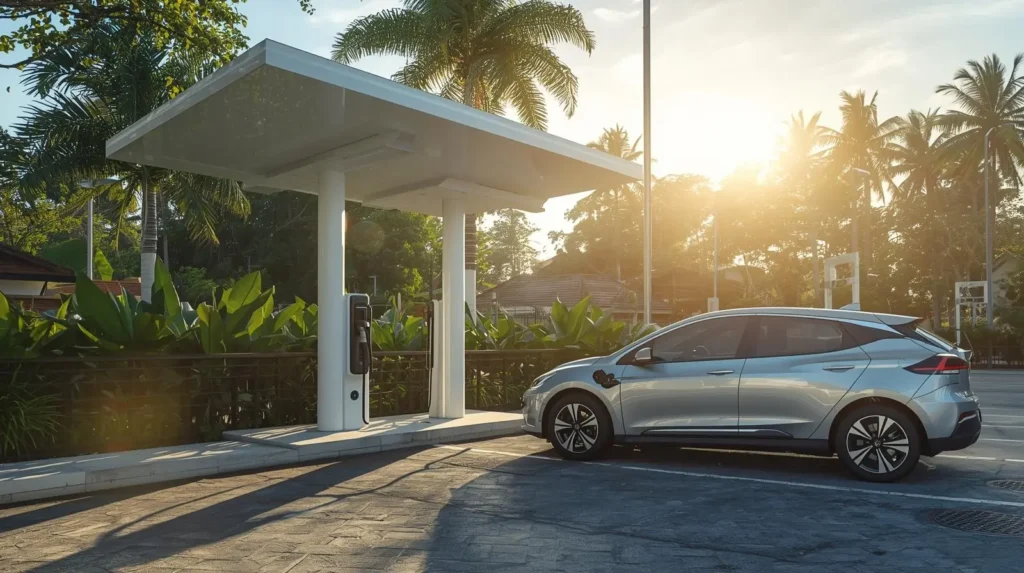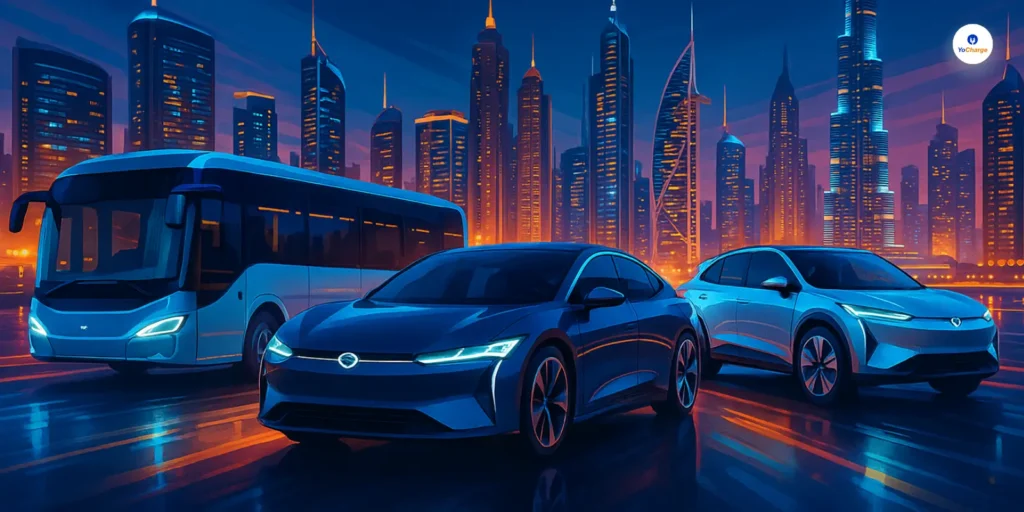
Electric vehicles (EVs) are rapidly gaining traction across the United States. Electric vehicle (EV) sales in the United States, Europe, and China covered around 95% of global EV sales in 2023. It increased by 35% in 2023 compared to 2022, totaling 40 million EVs on the road. [ref] This surge in popularity is driven by several factors, including environmental concerns, technological advancements that offer longer driving ranges, and government incentives. However, for widespread EV adoption to become a reality, affordable charging options are crucial. The electricity rate, also known as the tariff, is a significant factor affecting the cost of charging an EV in the USA. Electricity tariffs are typically measured in per-kilowatt hour (kWh) pricing. This per-kWh charging tariff means that the cost of charging your EV is directly tied to the price you pay per kWh of electricity.
Understanding Per-kWh EV Charging Tariffs
Per-kWh pricing refers to the cost of electricity measured by the kilowatt-hour (kWh). Think of it like buying gasoline by the gallon – you pay a certain price for each unit of energy you use. In the case of EV charging, the more kWh of electricity your car consumes, the higher the charging cost will be.
This directly impacts how much you pay to “fill up” your EV. For example, if the per-kWh rate is $.15 and your car’s battery requires 50 kWh to reach a full charge, the charging cost would be around $7.50 (50 kWh * $.15/kWh).
It is important to note that per-kWh pricing is just one piece of the puzzle. Here are some other factors that can influence your EV charging costs:
- Network Fees: Some charging stations may add a network fee on top of the per-kWh rate. This fee helps cover the cost of maintaining the charging infrastructure.
- Time-of-Day Pricing: Certain electricity providers offer time-varying rates, where the cost of electricity fluctuates depending on the time of day. Charging your car during off-peak hours (typically late night or early morning) can be significantly cheaper compared to peak hours.
By understanding these factors, you can make informed decisions about when and where to charge your EV.
Ranking US States Based On Per-kWh EV Charging Tariffs
This section ranks U.S. states based on their per-kWh EV charging tariffs, using data as of February 2024. The analysis aims to provide insight into the most affordable per-kWh rates for EV charging, helping consumers make informed decisions when choosing an electric vehicle.
| US State | Energy Rates (¢=cents) February 2024 | US National Rank |
|---|---|---|
| Alabama | 14.98 ¢/kWh | 47 |
| Alaska | 22.88 ¢/kWh | 22 |
| Arizona | 14.46 ¢/kWh | 37 |
| Arkansas | 11.89 ¢/kWh | 21 |
| California | 31.23 ¢/kWh | 42 |
| Colorado | 14.47 ¢/kWh | 3 |
| Connecticut | 29.52 ¢/kWh | 49 |
| Delaware | 15.73 ¢/kWh | 33 |
| Florida | 15.28 ¢/kWh | 45 |
| Georgia | 12.95 ¢/kWh | 28 |
| Hawaii | 43.93 ¢/kWh | 50 |
| Idaho | 11.26 ¢/kWh | 9 |
| Illinois | 15.72 ¢/kWh | 10 |
| Indiana | 14.11 ¢/kWh | 23 |
| Iowa | 12.15 ¢/kWh | 5 |
| Kansas | 13.74 ¢/kWh | 19 |
| Kentucky | 12.48 ¢/kWh | 25 |
| Louisiana | 11.25 ¢/kWh | 27 |
| Maine | 24.95 ¢/kWh | 32 |
| Maryland | 17.6 ¢/kWh | 46 |
| Massachusetts | 29.25 ¢/kWh | 44 |
| Michigan | 18.57 ¢/kWh | 16 |
| Minnesota | 14.36 ¢/kWh | 7 |
| Mississippi | 13.19 ¢/kWh | 39 |
| Missouri | 11.43 ¢/kWh | 17 |
| Montana | 11.96 ¢/kWh | 6 |
| Nebraska | 10.72 ¢/kWh | 8 |
| Nevada | 16.69 ¢/kWh | 40 |
| New Hampshire | 23.76 ¢/kWh | 34 |
| New Jersey | 17.69 ¢/kWh | 15 |
| New Mexico | 14.14 ¢/kWh | 2 |
| New York | 24.23 ¢/kWh | 30 |
| North Carolina | 15.1 ¢/kWh | 41 |
| North Dakota | 10.5 ¢/kWh | 13 |
| Ohio | 15.77 ¢/kWh | 26 |
| Oklahoma | 11.3 ¢/kWh | 20 |
| Oregon | 14.23 ¢/kWh | 24 |
| Pennsylvania | 17.02 ¢/kWh | 31 |
| Rhode Island | 30.97 ¢/kWh | 48 |
| South Carolina | 14.21 ¢/kWh | 38 |
| South Dakota | 11.79 ¢/kWh | 18 |
| Tennessee | 11.98 ¢/kWh | 29 |
| Texas | 14.31 ¢/kWh | 43 |
| Utah | 10.99 ¢/kWh | 1 |
| Vermont | 21.22 ¢/kWh | 14 |
| Virginia | 13.97 ¢/kWh | 36 |
| Washington | 11.4 ¢/kWh | 11 |
| West Virginia | 13.98 ¢/kWh | 35 |
| Wisconsin | 16.93 ¢/kWh | 12 |
| Wyoming | 11.47 ¢/kWh | 4 |

Reducing the cost to charge an EV in the USA: Key strategies
Several factors beyond the per-kWh EV charging tariffs can affect the cost to charge an EV in the USA. The major factors are as follows:
- Availability Of Public Charging Stations: The more widely available public charging stations are, the more convenient and affordable charging becomes for EV owners. Regions with sparse charging infrastructure, like the Great Plains, can make EV ownership less practical and more costly.
- Access To Renewable Energy Sources: EVs charged with electricity generated from renewable sources like solar and wind have a lower environmental impact and can be more cost-effective. Integrating renewable energy with EV charging infrastructure is an important factor for affordability. However, platforms like YoCharge making it possible.
- Government Incentives And Policies: Federal and state-level incentives like tax credits and rebates can significantly reduce the upfront cost of EVs and charging equipment. Policies mandating zero-emission vehicle sales, like in California, also drive EV adoption and infrastructure investment.
- Charging Speed: Faster Level 3 DC charging is more expensive than slower Level 1 or 2 AC charging. Optimizing charging speeds to match driver needs can help manage costs.
- Electricity Rate Structures: Time-of-use rates that incentivize charging during off-peak hours can lower electricity costs. Utilities are increasingly offering special EV electricity rates to encourage adoption.
- Workplace And Multifamily Charging: Access to free or subsidized charging at work or in apartment buildings can reduce the need for public charging and lower overall costs.
A combination of public policy, utility rate design, charging infrastructure deployment, and renewable energy integration will be key to making EV charging more affordable and accessible for all EV drivers.
Final Thoughts
In this article, we have discussed significant variations in electric vehicle (EV) per-kWh EV charging tariffs across different U.S. states. Factors beyond per-kWh rates, such as the availability of public charging stations, access to renewable energy sources, and government incentives, can impact the affordability of EV charging. Optimizing charging speeds, and electricity rate structures, and promoting workplace and multifamily charging can help manage EV charging costs.
The future of EV charging infrastructure holds promising advancements. It includes continued investment in public charging networks, increased integration of renewable energy sources, advancements in charging technology, and more. It also needs ongoing policy support and incentives from federal and state governments to encourage EV adoption and infrastructure development. This is crucial for policymakers, utilities, and charging infrastructure providers to work together to ensure that EV charging remains accessible for all drivers.
Also Read



